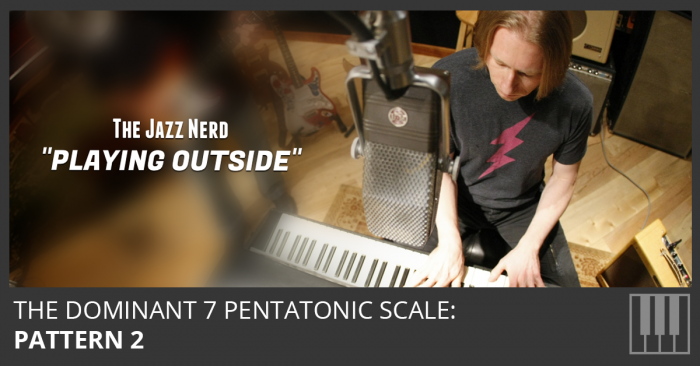This dominant 7 pentatonic pattern gets tougher again. It has four notes in C and four notes in D flat but they are all spread throughout the bar. Again, this pattern helps you to get comfortable transposing quickly. And all of these patterns … [Read more...]
Playing Outside: The Dominant 7 Pentatonic Scale Pattern 4
This pattern should be easier than the previous dominant 7 scale pattern. The transposition doesn't split the bar so you only have to think about transposing once during the full pattern. The rewarding function of this pattern is that you can use … [Read more...]
Playing Outside: The Dominant 7 Pentatonic Scale Pattern 3
This dominant 7 pentatonic pattern is similar to the previous pattern. It still moves up a half step for a total of 2 notes in an eight note pattern. But this time, the transposed notes are the fifth and eighth notes in the sequence. This means that … [Read more...]
Playing Outside: The Dominant 7 Pentatonic Scale Pattern 2
If Dominant 7 Pentatonic Scale Pattern 2 seemed easy to you, I guarantee you'll find this next one more challenging. Last time, we took a four-note pattern and transposed it up a half step for the second half of the bar. This time, we're using a … [Read more...]
Playing Outside: The Dominant 7 Pentatonic Scale Pattern 1
John Coltrane loved the Dominant 7 Pentatonic Scale. During the 60s, Trane (and other avant-garde musicians like Ornette Coleman) created a unique and dissonant style of "playing outside" the chord changes. Often, they would play a half-step … [Read more...]
Piano Voicings Part 3: Fourth Chords
Fourth chords create harmonies reminiscent of McCoy Tyner's playing. Stacked fourths have a wide open texture and are complimented very well by pentatonic scales. Begin on the third of a major scale and keep adding fourths as your taste dictates. … [Read more...]

